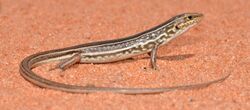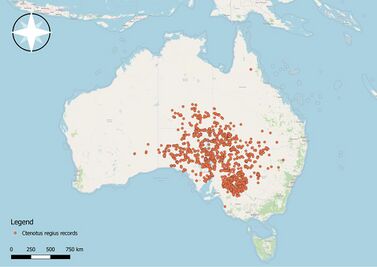Biology:Ctenotus regius
| Ctenotus regius | |
|---|---|

| |
| Scientific classification | |
| Domain: | Eukaryota |
| Kingdom: | Animalia |
| Phylum: | Chordata |
| Class: | Reptilia |
| Order: | Squamata |
| Family: | Scincidae |
| Genus: | Ctenotus |
| Species: | C. regius
|
| Binomial name | |
| Ctenotus regius Storr, 1971
| |
The pale-rumped ctenotus or regal striped skink (Ctenotus regius) is a medium-sized species of skink with an arid distribution restricted to the Australia n Mainland,[2] which belongs to the largest group of reptiles in Australia, Ctentotus (containing close to 100 species).[3]
Description
Ctentotus regius is a medium-sized skink, characterised by its longitudinally striped back and white spotted sides.[2] The species has a reddish-brown tail and its body is patterned by a blackish brown colour with a white-cream lateral stripe that runs from over the ear to below the eye, and white side spots in between the longitudinal lines that span the length of its body.[2] The average snout-to-vent length of the species is 7.2 cm[4] with females being recorded as slightly larger, on average, than their male counterparts.[5]
Taxonomy
Ctenotus regius was first described by Glen Milton Store in 1970,[6] and has not since had a name revision.
The pale-rumped ctenotus is a member of the skink family (Scincidae), and the genus Ctenotus, often described as 'comb-eared' for its row of small scales on the anterior edge of its ears.[7] Many of the species within this genus are exceedingly similar in shape, build and appearance, with many differences only identifiable in their size and foraging and sheltering behaviours.[7]
Distribution
Ctentotus regius is endemic to Australia, with a distribution isolated to the in north-west of New South Wales, the south-west of Queensland, the south-east of Northern Territory, the north-east of South Australia and the north-west of Victoria.[2] Atlas of Living Australia currently holds 7,697 records for the species across Australia, although some of these may be misidentifications.[2] Records for the species exist in a number of National Parks and Nature Reserves within New South Wales, including Mallee Cliffs NP, Tarawi NR, Mungo NP, Sturt NP, Kinchega NP, Nocoleche NR and Yathong NR.[8]
Ecology and habitat
The pale-rumped ctenotus inhabits sandy and loamy deserts in central Australia, seeking refuge in low shrubs including saltbush (Atriplex spp.), bluebush (Maireana spp.) and nitre bush (Nitraria billardierei).[2]
Although much is still unknown about the species' ecological ties to its predators and prey, grey butcherbirds (Cracticus torquatus) have been observed preying upon the species in Murray-Sunset National Park in Victoria.[3]
The species has been observed to occupy a home range, with estimates ranging from 40-60 square metres.[5]
Reproduction and lifecycle
The pale-rumped ctenotus is an oviparous (egg-laying) species.[11] Females are on average larger than their male counterparts and lay a clutch of approximately two eggs early in summer, although reproductive efforts have been noted to vary considerably with environmental conditions.[5] The pale-rumped ctenotus has a relatively short lifespan of approximately 3 years, in contrast to other Ctenotus species such as C. leonhardii with specimens recorded as living for as long as 7 years.[5]
Diet
Ctentotus regius is largely an unspecialised insectivore, although it may occasionally consume plant material.[5]
Conservation
Ctenotus regius is listed as a species of least concern on the IUCN Red List.[1] However, many pressures impact desert reptile populations within Australia, including habitat loss from land clearing, habitat degradation and modification as a result of introduced pest species and anthropogenic climate change, vehicle collisions and emerging diseases.[4]
References
- ↑ 1.0 1.1 Fenner, A.; Hutchinson, M.; McDonald, P.; Robertson, P. (2018). "Ctenotus regius". IUCN Red List of Threatened Species 2018: e.T109464279A109464294. doi:10.2305/IUCN.UK.2018-1.RLTS.T109464279A109464294.en. https://www.iucnredlist.org/species/109464279/109464294. Retrieved 20 November 2021.
- ↑ 2.0 2.1 2.2 2.3 2.4 2.5 Australia, Atlas of Living. "Species: Ctenotus regius (Pale-Rumped Ctenotus)" (in en-AU). https://bie.ala.org.au/species/urn:lsid:biodiversity.org.au:afd.taxon:8c3e3bba-9714-4519-83c5-3ea754169af7.
- ↑ 3.0 3.1 Fitzsimons, James A.; Thomas, Janelle L. (2010). "Ctenotus regius (Regal Striped Skink). Predation". Herpetological Review 41 (1): 76–77. https://www.researchgate.net/publication/259391700.
- ↑ 4.0 4.1 "Royal ctenotus (Ctenotus regius) at the Australian Reptile Online Database | AROD.com.au" (in en). http://www.arod.com.au/arod/reptilia/Squamata/Scincidae/Ctenotus/regius.
- ↑ 5.0 5.1 5.2 5.3 5.4 Read, J. L. (1998). "The ecology of sympatric scincid lizards (Ctenotus) in arid South Australia". Australian Journal of Zoology 46 (6): 617–629. doi:10.1071/ZO97063. https://www.publish.csiro.au/zo/zo97063.
- ↑ "Ctenotus regius". https://reptile-database.reptarium.cz/species.php?genus=Ctenotus&species=regius.
- ↑ 7.0 7.1 "Ctenotus - Australian Lizards" (in en). http://australian.museum/learn/animals/reptiles/ctenotus-australian-lizards/.
- ↑ "Environment & Heritage | NSW BioNet". https://www.environment.nsw.gov.au/atlaspublicapp/UI_Modules/ATLAS_/atlasreport.aspx#.
- ↑ Australia, Atlas of Living. "Species: Ctenotus regius (Pale-Rumped Ctenotus)" (in en-AU). https://bie.ala.org.au/species/urn:lsid:biodiversity.org.au:afd.taxon:8c3e3bba-9714-4519-83c5-3ea754169af7.
- ↑ "Google Maps" (in en). https://www.google.com.au/maps/@-33.8134455,150.9687296,14z.
- ↑ "Ctenotus regius". https://reptile-database.reptarium.cz/species.php?genus=Ctenotus&species=regius.
Wikidata ☰ Q3006585 entry
 |



